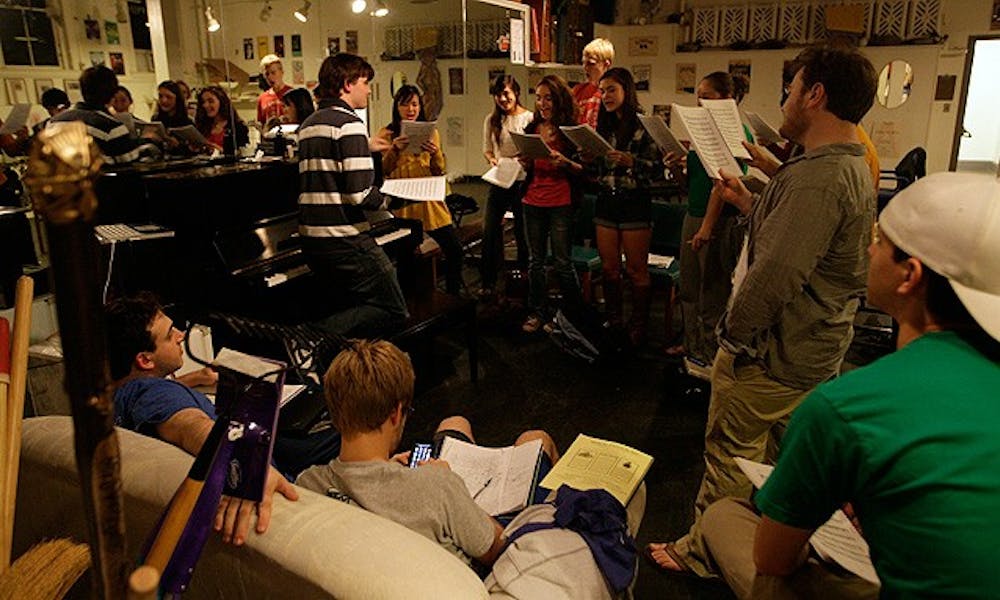Fresh on the heels of its mostly sold-out fall show Into the Woods, Hoof ‘n’ Horn has entered its 75th season as the self-proclaimed oldest student-run theatrical group in the South.
Hoof ‘n’ Horn President Nathaniel Hill, a junior, said the student organization prides itself on being completely self-sufficient.
“We are an entirely independent musical theater company, entirely student-run,” Hill said. “Everything that you see—from the business management and budgeting to the marketing, choreography, directing, all the set design, all the building of the set, every instrument you hear—is students.”
Hoof ‘n’ Horn does not receive funding from the University. As an independent organization, they must fund each production based on the previous show’s revenue, some donations and program advertisements. They also apply for Student Organization Funding Committee grants from Duke Student Government. Hill said costs for each show include everything from costumes to lumber for the set. He likens managing Hoof ‘n’ Horn to running a business—a rare opportunity for a 20-year-old student.
Instructor in Theater Studies Dan Ellison acts as faculty advisor to the group but describes his role as an observer. He currently teaches a course on Nonprofit Cultural Institutions and said the weekly Hoof ‘n’ Horn executive committee meetings “are run as well or better than a lot of nonprofit arts organizations that I’m familiar with.”
Like all recipients of SOFC funds, Hoof ‘n’ Horn allows any student to participate, which means membership is not strictly defined. Hill estimates that over the course of a year around 150 to 200 students are involved in at least one show in some way and that roughly 50 participate in two or more shows. The group serves a social as well as theatrical function for its members: It has two social chairs who plan parties throughout the year, as well as an annual beach trip.
Junior Vivek Patel, Hoof ‘n’ Horn vice president and fall producer, got involved in the technical side of Hoof ‘n’ Horn productions as a freshman.
“They needed somebody to help with the sound design; I actually had no theater experience before I got here,” he said. “The guy who was helping me was a professional sound designer. He had worked on Broadway shows before. So I learned a whole lot of stuff from him.”
Patel recently produced Into the Woods. After acquiring the rights to the show, he appointed the production council, which includes the director and choreographer, and he oversaw marketing, auditions and casting. He also arranged for Hoof ‘n’ Horn to perform a medley for the Board of Trustees.
Putting on the show independently as students is challenging, Patel said, especially in the technical aspects, but the control they have over the process is ultimately rewarding.
“We can choose whatever we want to do,” Patel said. “We can direct the show however we want to direct it. Because we have all that power, it’s really good life experience. You have to make everything work yourself.”
Hoof ’n’ Horn was started in 1936 and performed a student-written show called The Devil Grins.
The group performed annual, student-written musicals (with the exception of Anything Goes in 1952) until 1961, when they transitioned to more typical Broadway shows, like Once Upon A Mattress, Bye-Bye Birdie and Guys and Dolls. Now Hoof ‘n’ Horn produces three mainstage shows each year and one children’s show.
Professor Jeff Storer came to the Department of Theater Studies in 1982. He has watched Hoof ‘n’ Horn develop in the 28 years since and collaborated with them on Carousel and Cole, two shows they co-produced with Theater Studies.
“One of the really incredible things [about Hoof ‘n’ Horn] is institutional memory,” Storer said. “They do a terrific job of passing down year after year after year the core of the organization. They do a great job of teaching the next generation, passing down what Hoof ‘n’ Horn is and what they do in such a well-organized and focused way.”
Holly LeCraw, Trinity ’88, performed in almost every Hoof ‘n’ Horn show during her time at Duke. Now a published author, she wrote in an e-mail that her time with Hoof ‘n’ Horn was “absolutely the most important part of my Duke experience.”
“The poise you learn from being onstage and dealing with the inevitable stumbles and crises is invaluable for any profession,” LeCraw said. “There have been countless times that I’ve gone into ‘the show must go on’ mode when I am nowhere near a stage. Also, since I’ve published my first book and have been touring with it, I feel like I’m performing again in a small way, and I am definitely drawing on that experience.”
In conjunction with the 75th season, current Hoof ‘n’ Horn leaders are planning an invigorated outreach program to connect current students with Hoof ‘n’ Horn alumni like LeCraw. Elements might include a regular alumni newsletter, master classes hosted by visiting Hoof ‘n’ Horn alumni and a reception during reunion weekend, when the spring show Aida will be performed.
“Networking is very important, and a sense of the past is important too,” LeCraw said. “I remember alumni visiting when I was a freshman, and it made a big impression on me.”
As they enter Hoof ‘n’ Horn’s 75th year with the winter show Chess, the group’s leadership said they have a sense of confidence in their current situation. Hill noted that audition pools this year were significantly increased from last year. He added that attendance has also gone up—more than 2,000 people went to Rent last spring, and Into the Woods sold out seven of its 10 shows.
In Patel’s words, “Hoof ‘n’ Horn is on the up.”
Get The Chronicle straight to your inbox
Signup for our weekly newsletter. Cancel at any time.

